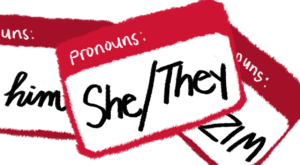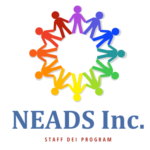Pronouns & Email Signatures – One Step to an Inclusive Workplace
The dictionary’s inclusion of the singular “they” as a nonbinary pronoun in 2019 illustrates a relatively recent, although rapid, shift in society’s acceptance of gender identity. In keeping with this shift, more and more organizations have encouraged employees to include gender pronouns in their email signatures. The impact this can have may not be immediately obvious, but there are important reasons behind sharing pronouns beyond signifying and claiming your identity – including creating a more inclusive work environment.
To understand the potential impact on inclusion in the workplace, we need to look at several other related concepts: Marginalization, Allyship, and Privilege.
MARGINALIZATION
Marginalization occurs when certain people — or, in a workplace setting, employees — are treated as invisible, as if they aren’t there or their skills or talents are unwelcome or unnecessary. In general, the major groups that are cited as marginalized are ethic and religious minorities, disabled persons, LGBTQ people and women. In the workplace context, marginalization is the result of systemic actions that the “in group” takes — whether consciously or unconsciously — to alienate or disenfranchise a specific person or groups of people by sidelining them from the group’s main activities and contributions.
Marginalization can manifest itself both subtly and overtly. These manifestations can include:
- Use of derogatory language
- Assuming someone’s accomplishments aren’t based on merit
- Expecting someone to act a certain way based on stereotypes about their identity
- Denying someone professional opportunities because of their identity (e.g., racism, sexism and ableism)
- Not providing equal access to resources based based on membership in a particular group
- Overlooking, criticizing or interfering with a person’s cultural or religious traditions and values
- Systemic and/or institutionalized barriers to access and support
ALLYSHIP
An ally can be defined as someone who is not a member of a marginalized group but who wants to support and take action to those in that group. Allyship, or support of a marginalized group, in the workplace is crucial for building inclusion and equality.
There are many ways we can be an ally:
- Learn about the issues facing a marginalized group (check out the resources on this website, for example)
- Listen to what the marginalized group needs from you as an ally (change policies, challenge behaviors) vs assuming you know what they need
- Keep trying – don’t be afraid to make mistakes
- Advocate and use your position of privilege to help others
PRIVILEGE
Privilege exists when one group has something of value that is denied to others simply because of the groups they belong to, rather than because of anything they’ve done or failed to do. Access to privilege doesn’t determine one’s outcomes, but it is definitely an asset that makes it more likely that whatever talent, ability, and aspirations a person with privilege has will result in something positive for them.
By acknowledging and recognizing privilege, we can understand the importance of speaking out in situations where we do have privilege, where we can hopefully make a difference and be an ally to those marginalized communities.
PRONOUNS
Pronouns Matter: Nothing may be more personal than the way in which people refer to us through our name and pronouns. Using a person’s chosen name and desired pronouns is a form of mutual respect and basic courtesy. That said, gender identity is not visible – it’s an internal sense of one’s own gender. While most people align across their birth-assigned sex, their gender identity, their gender expression and how everyone else interprets their gender – some people do not, which means we can’t assume we know someone’s pronouns.
The experience of being misgendered can be distracting, hurtful, and even angering. The experience of accidentally misgendering someone can be embarrassing for both parties, creating tension and leading to communication breakdowns across teams and with customers.
So why put pronouns in email signatures? The answer is connected to allyship & privilege.
When pronouns began to become more visible in the workplace, it sparked discussions and questions from cisgender people such as “why do we need to put pronouns in our email signatures too?” (A cisgender person is someone whose gender identity matches the sex they were assigned at birth, e.g. someone who identifies as a man and was identified as male when he was born.) While their questions did not come from a malicious place, they did come from a place of unrealized privilege, because neither they nor anyone else had ever questioned the pronouns they go by. Including your pronouns, even if they are the majority, shows that you recognize this and are using your place of privilege to support those who may be marginalized.
Sharing your pronouns communicates a few things to other people, especially to people who preferred pronouns do not match their outward gender identity. It communicates:
- Hey – I recognize and understand that people’s pronouns may not match their outward gender identity
- I’m communicating my pronouns to create a space where someone else can feel comfortable sharing their pronouns if they wish
- I’m normalizing the practice of sharing pronouns so that people do not feel singled out in having to share their pronouns if their pronouns do not match their gender identity
- I’m sharing my pronouns so you don’t have to make assumptions about my gender identity and therefore I won’t make assumptions about yours.
Sharing pronouns in your email signature is just one way to communicate your pronouns. Other ways include: wearing a pronoun pin, adding your pronouns to your Zoom name or a name tag, stating pronouns in a staff directory, or stating your pronouns when you meet someone new (Ex: “Nice to meet you – my name is Abby and my pronouns are she/her.”) Some ways of sharing pronouns are internal to NEADS (the staff directory) and other ways of sharing pronouns can be external (email signature, Zoom name).
Some ways of sharing pronouns are solely internal (for example, sharing pronouns in a staff directory). Other ways, such as putting pronouns in your email signature, communicate to external colleagues and stakeholders as well as internal colleagues that you understand pronouns and are normalizing the practice of sharing pronouns. Since each role at NEADS is different and has varying styles and forms of communications, we believe that the emphasis should be put on educating staff about why we encourage the practice of sharing and communicating pronouns but leave the choice of which form that sharing specifically takes to the individual employee.
In conclusion, an act as simple as adding pronouns to email signatures can set a norm and encourage others to do the same. It is one incremental way we can help make our workplace a more accepting and inclusive place for all. For people who have never thought about their gender pronouns, the practice of including pronouns in an email signature might not seem that important. Remember, though, that this stance most likely comes from a place of privilege: No one has ever questioned the pronouns they go by. However, those who have been referred to incorrectly know how disrespectful and harmful it can be to be misgendered. As more and more people use share their pronouns by including them in an email signature or some other way, these instances will hopefully occur less and less.
Reflection: How does sharing your pronouns relate to Allyship?

